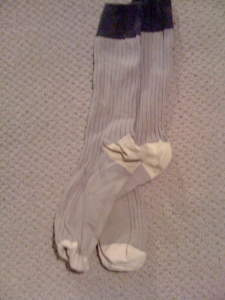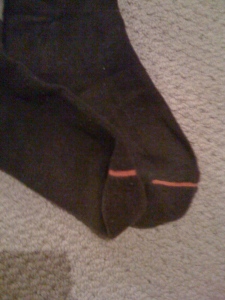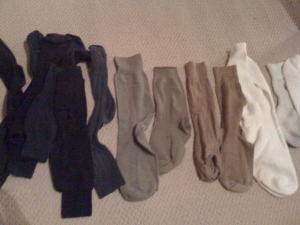Yesterday’s article about primary product requirements generated a great deal of traffic and several interesting and insightful comments. To recap, I was talking about examples of products from every-day life that fail to meet some core use cases. The product that generated most of the buzz was the lowly sock. I suggested that there is room for a sock vendor to differentiate itself by focusing on two use cases or user goals:
- Rapid sorting of a pile of socks that belong to different feet in the same family.
- Quickly finding matching socks in the dim morning light without waking up one’s roommate. Bonus points for helping the user ensure he doesn’t pick dark blue socks when he’s looking for black.
Sock vendors everywhere compete on the same things, namely brand identity, style, comfort, material, and price. To step out from the crowd, I suggest that they focus on the whole product experience, not just the wearing of the socks, but the sorting and matching. Advertise that and I think they’d have a clearly differentiated product. I was somewhat surprised that two readers suggested that I should throw away existing socks and buy copious pairs of identical black ones. (Though I will admit that the red/pink ones I showed in the picture are pretty worn out; I wear them so much because they’re so easy to sort!) There were two variants of this suggestion (here and here), but as Saeed and I each responded separately, these suggestions reminded us both of internal discussions where company insiders want the user to do something unnatural to accommodate product deficiencies. Saeed said it reminded him of situations where “Technical Support suggests a customer reinstall their software when some strange problem occurs. It’s not an appropriate solution.” Poor tech support reps; how many of them complain about these deficiencies release after release with no improvements.  I said that these ideas reminded me of developers who want to assume a clean slate in the buyer environment, but the fact is that people rarely if ever start from scratch and your product always has to fit in the customer’s existing environment with all its flaws. To be fair though those ideas could work for a specific buyer persona: Single male living alone with no interest in whether the socks make the man, and also enough disposable income to pitch all sock, and the mindset to do that. Certainly that’s a niche, but I don’t see how a vendor can exploit it. Perhaps offering a pack of 19 identical socks would work, de-emphasizing the pairs and emphasizing their identical and interchangeable aspect. In any case the point is to find and solve the hidden problems (sorting and easy matching in the dark), and in doing so find something that few vendors consider. I’ve never seen socks marketed for this use case.
I said that these ideas reminded me of developers who want to assume a clean slate in the buyer environment, but the fact is that people rarely if ever start from scratch and your product always has to fit in the customer’s existing environment with all its flaws. To be fair though those ideas could work for a specific buyer persona: Single male living alone with no interest in whether the socks make the man, and also enough disposable income to pitch all sock, and the mindset to do that. Certainly that’s a niche, but I don’t see how a vendor can exploit it. Perhaps offering a pack of 19 identical socks would work, de-emphasizing the pairs and emphasizing their identical and interchangeable aspect. In any case the point is to find and solve the hidden problems (sorting and easy matching in the dark), and in doing so find something that few vendors consider. I’ve never seen socks marketed for this use case. It’s crucial folks that you get out there and observe your customers in action. (Not sure how sock vendors do this.) Standard customer interviews fail to reveal some really crucial aspects such as the one we’re discussing here. As a test, it would be interesting to see if interviews with sock users would ever reveal the sorting problem. Talk to 5 friends about how they buy socks, what they like and dislike about the socks they’ve bought, and what characteristics they see as most important. You’re not allowed to lead the witness; conduct a real interview as if you hadn’t thought of the sorting problem. How many of the sock users would mention sorting and matching? On the other hand, if you invest more time and look at the whole picture, problems emerge that just seem like unavoidable problems:
It’s crucial folks that you get out there and observe your customers in action. (Not sure how sock vendors do this.) Standard customer interviews fail to reveal some really crucial aspects such as the one we’re discussing here. As a test, it would be interesting to see if interviews with sock users would ever reveal the sorting problem. Talk to 5 friends about how they buy socks, what they like and dislike about the socks they’ve bought, and what characteristics they see as most important. You’re not allowed to lead the witness; conduct a real interview as if you hadn’t thought of the sorting problem. How many of the sock users would mention sorting and matching? On the other hand, if you invest more time and look at the whole picture, problems emerge that just seem like unavoidable problems:
- businessman shows up to an important meeting wearing black dress pants and navy socks.
- man shows up wearing two different but similar-looking socks.
- a pile of unsorted socks in a sock drawer.
If you go out and collect requirements, it would be hard to uncover the problems above, and potentially identify an untapped differentiator. Carefully observe the user’s life, and market share could be yours. And finally, in case you missed it in the comments, Saeed referred to an earlier post showing a vendor who has at least noticed the problem and tried a solution:
Saeed’s post on this topic is really worth a read. I laughed uproariously at his last product idea. – Alan Previous post on this topic:
